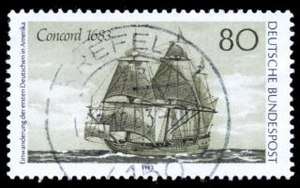German-American Day
| German-American Day | |
|---|---|
 1983 Stamp | |
| Observed by | German-Americans |
| Type | Cultural |
| Date | October 6 |
| Next time | October 6, 2019 |
| Frequency | Annual |
German-American Day (German: Deutsch-Amerikanischer Tag) is a holiday in the United States, observed annually on October 6 under Pub.L. 100–104, 101 Stat. 721.[1]
History
German-American Day, which celebrates German American heritage, commemorates the date in 1683 when 13 German families from Krefeld,[nb 1] near the Rhine, landed in Philadelphia. These families subsequently founded Germantown, Pennsylvania, the first German settlement in the original thirteen American colonies,[2] and organized the first petition in the English colonies to abolish slavery in 1688. Originally known under the rubric of "German Day", the holiday was celebrated for the first time in Philadelphia in 1883, on the occasion of the 200th anniversary of the arrival of the settlers from Krefeld; and similar celebrations developed later in other parts of the country.[3] The custom died out during World War I as a result of the anti-German sentiment that prevailed at the time,[2] but the holiday was revived in 1983 in joint resolution 108. The bill was sponsored by Senator Richard G. Lugar (R–IN) on April 8, 1987.[4]
Observances
In 1983, President Ronald Reagan proclaimed October 6 as German-American Day to celebrate and honor the 300th anniversary of German immigration and culture to the United States.[5] On August 6, 1987, Congress approved S.J. Resolution 108, designating October 6, 1987, as German-American Day. It became Pub.L. 100–104, 101 Stat. 721 when President Reagan signed it on August 18. A proclamation (#5719) to this effect was issued October 2, 1987, by President Reagan in a formal ceremony in the White House Rose Garden, at which time the President called on Americans to observe the Day with appropriate ceremonies and activities.
Presidents since then have continued to make proclamations to observe German-American Day.[6][7]
See also
Notes
- ↑ At the time (1598-1701) Krefeld was ruled by the House of Orange, the Netherland's ruling house. It is thought that at least some of the immigrant families had moved into Dutch-controlled Krefeld to avoid religious persecution in other German states.
References
Citations
- ↑ "STATUTE-101-Pg721" (PDF). United States Government Publishing Office. Washington, D.C.: United States Government. August 18, 1987. Retrieved October 12, 2017.
- 1 2 "German-American Day: A Short History". German-American Heritage Society of Greater Washington, D. C.. Washington, D. C.: German-American Heritage Foundation of the USA. Yahoo! GeoCities. Archived from the original on October 25, 2009. Retrieved October 12, 2017.
- ↑ Kazal 2004, p. 136.
- ↑ "S.J.Res.108 - A joint resolution to designate October 6, 1987, as "German-American Day"". Library of Congress. Washington, D.C.: Congressional Research Service. April 8, 1987. Retrieved October 12, 2017.
- ↑ Reagan, Ronald (January 20, 1983). "Tricentennial Anniversary Year of German Settlement in America". U.S. Diplomatic Mission to Germany. Berlin: United States Department of State. Retrieved July 29, 2007.
- ↑ "Presidential Proclamation -- German-American Day, 2015". whitehouse.gov. 2015-10-05. Retrieved 2018-10-04.
- ↑ "German-American Day, 2017" (PDF). Federal Register. Washington, D.C.: National Archives and Records Administration. October 6, 2017. Archived from the original on October 11, 2017. Retrieved October 12, 2017.
Sources
- Kazal, Russell A. (2004) [1815]. 'Becoming Old Stock: The Paradox of German-American Identity. Princeton, New Jersey: Princeton University Press. p. 136. ASIN B01FGN7SLO.
External links
- German-American Heritage Foundation of the USA in Washington, DC
- German-American National Congress
- Motion picture film of ceremonies held in Hindenburg Park in Los Angeles, California on German Day, 1936, from the Hoover Institution Archives.